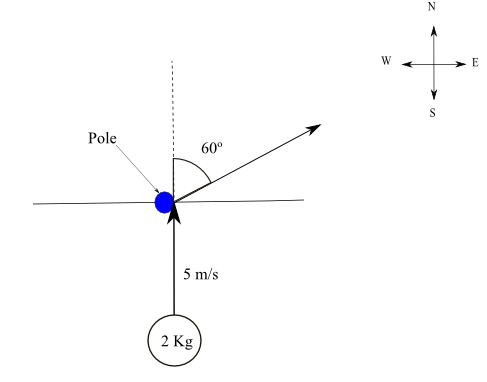p = m v
k = (1/2) m v2
M = 2 m and V = 2 v (mass and velocity doubled)
P = M V = (2m)(2v) = 4 m v momentum is quadrupled.
K = (1/2) M V2 = (1/2) (2 m) (2 v) 2 = (1/2) 8 m v2 : kinetic energy is multiplied by 8
Answer: D
Equal momenta
|p1| = m1 |v1| and |p2| = m2 |v2| , magnitude of momenta of objects A and B
Let K1 = (1/2) m1 |v1|2 and K2 = (1/2) m2 |v2|2 , kinetic energies of objects A and B
We know that
|v1| < |v2|
Multiply both sides of the above inequality by (1/2) |p1| and (1/2) |p2| taking into account that |p1| = |p2|
(1/2) |p1| |v1| < (1/2) |p2| |v2|
Substitute |p1| and |p2| by their expressions given above to obtain
(1/2) m1 |v1| |V1| < (1/2) m2 |v2| |v2|
which gives
K1 < K2
The kinetic energy of B is greater than that of A
Answer: D
Equal kinetic energies
K1 = (1/2) m1 |v1|2 , K2 = (1/2) m2 |v2|2 , kinetic energies of objects A and B are equal
K1 = K2 given
Let |p1| = m1 |v1| and |p2| = m2 |v2| , the momenta of objects A and B
We know that
|v1| < |v2|
Divide the numerator and denominator in the above by K1 and K2 (note K1 = K2), to obtain
|v1| / K1 < |v2| / K2
Which gives
K1 / |v1| > K2 / |v2|
Substitute K1 and K2 by their expressions given above
(1/2) m1 |v1|2 / |v1| > (1/2) m2 |v2|2 / |v2|
Simplify to obtain
m1 |v1| > m2 |v2|
Which gives |p1| > |p2|
Answer: B
The brakes in a car are used to stop the car hence to change the momentum of the car from some value to zero. The relationship between an applied force to an object of mass m and the change of its momentum in physics is given by
F Δt = Δp = m (vf - vi) , vf final velocity and vi initial velocity, Δ t is the time during which force F is applied.
in magnitude
|F| Δ t = m |vf - vi| , assuming vf and vi either in same or opposite directions.
Δ t
Δ t = 2000 |0 - 35| / 4000 = 17.5 seconds
Answer: E
Momentum before collision: m1 v1 + m2 v2
Momentum after collision: (m1 + m1)(1/2)(v1 + v2)
Momentum are conserved m1 v1 + m2 v2 = (m1 + m1)(1/2)(v1 + v2)
Multiply all terms by 2, expand and simplify
m1 v1 - m1 v2 + m2 v2 - m2 v1 = 0
factor
m1 (v1 - v2) - M2(v1 - v2) = 0
(m1 - m2)(v1 - v2) = 0
taking into account that v1 is not equal to v2, solve the above equation to obtain
m1 = m2
Answer: D

Momentum before hitting the pole: p1 = m v = 2 × 5 = 10 K.m/s one component (only) to the north
Momentum after hitting the pole: 2 components: to the north p2n = 2 × 5 cos (60°) to the east: p2e = 2 × 5 sin (60°)
Change in magnitude of components: p2n - p1 = 2 × 5 cos (60°) - p1 = 5 - 10 = - 5 Kg.m/s
Answer: C
Momentum before collision: p1 = 4×6 + 6×5 = 54 Kg.m/s
Momentum after collision: p2 = (4 + 6) v2 ; v2 is the velocity of the two objects together after collision
momentum is conserved: 54 = 10 v2
v2 = 5.4 m/s
Kinetic energy before collision: K1 = (1/2) (4) 62 + (1/2) (6) 52 = 147 J
Kinetic energy after collision: K2 = (1/2) (4 + 6) 5.42 = 145.8 J
Change in kinetic energy: K2 - K1 = 145.8 - 147 = - 1.2 J
1.2 J of kinetic energy was lost.
Answer: A
Momentum before collision: p1 = 0 Kg.m/s (both objects at rest)
We assume an object moving to the right is moving in the positive direction.
Momentum after collision: p2 = 1 (-9) + 3 (v2) = - 9 + 3 v2; v2 is the velocity of object B
momentum is conserved: 0 = - 9 + 3 v2
v2 = 3 m/s and B moving to the right
Answer: B
Answer: D
Assuming positive motion when an object moving to the right. Since both objects moving along a straight line, the velocities have one component along the path of motion which a straight line and this component is either positive (to the right) or negative (to the left).
momentum before collision: p1 = m1 |v1| - m2 |v2| , |v2| the magnitude of object B.
momentum after collision: p2 = 0 (they both stop hence velocities equal to 0 after collision).
conservation of momentum: m1 |v1| - m2 |v2| = 0
Solve for |v2|
|v2| = |v1| (m1 / m2)
Answer: B